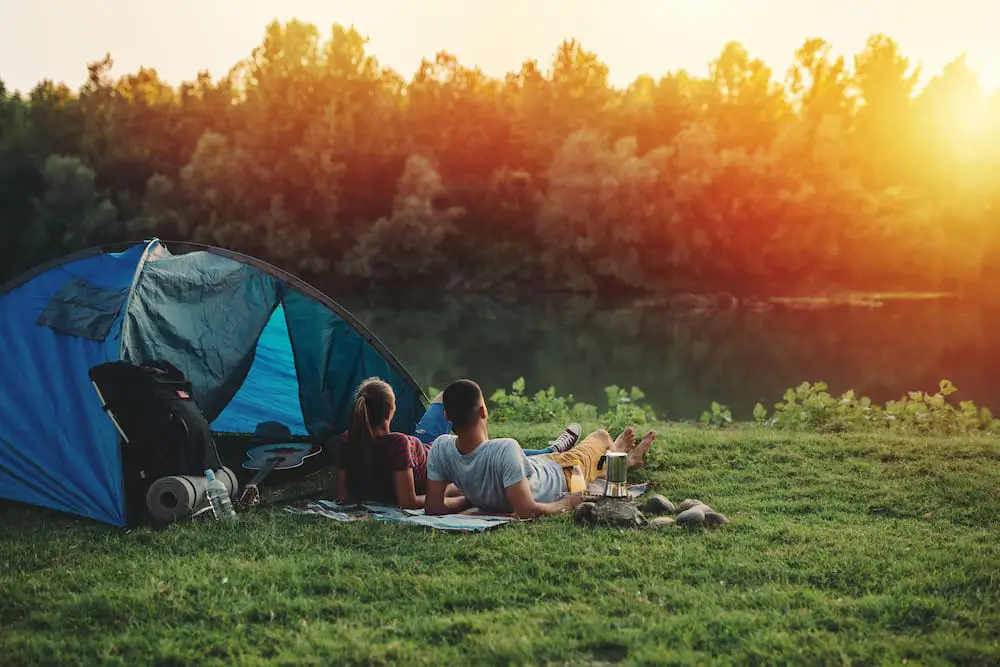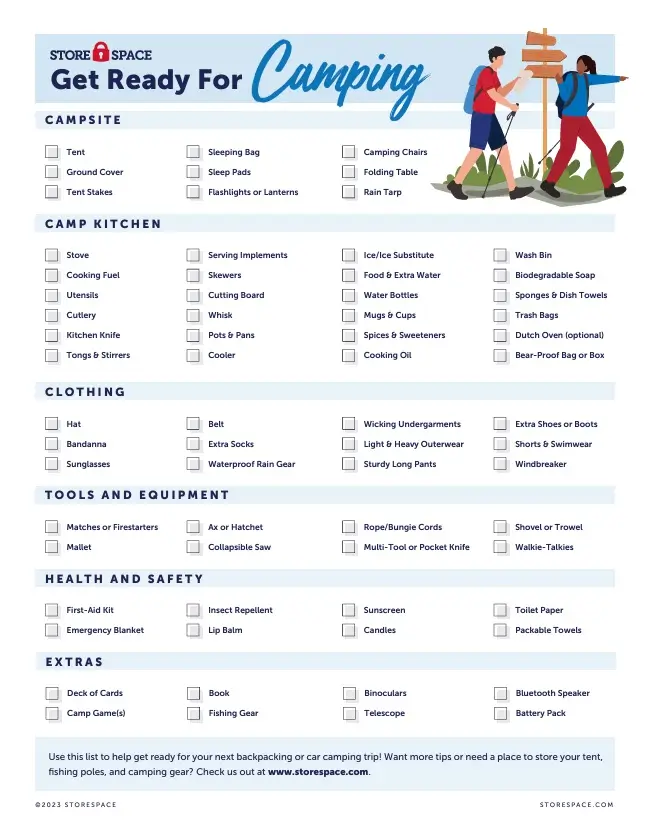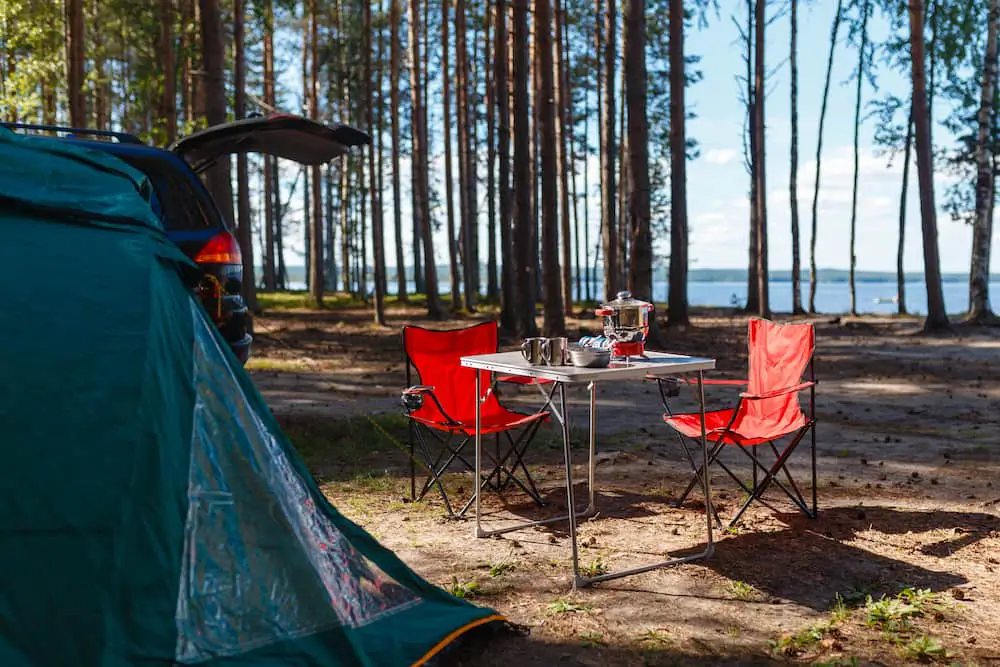Camping is a great way to get away from it all, enjoy the great outdoors and even get a little exercise along the way. But preparing for a camping trip without a plan can be a stressful process, putting a damper on the whole trip.
That’s why we’re putting together our camping essentials checklist, so that you need not worry about remembering all the minutiae at the last minute.
Camping means different things to different people. For some, it’s a strenuous hike through the backcountry, followed by gathering wood and eating nuts, berries and dehydrated beef stroganoff. For others, it’s driving up to a campsite, taking the tent out of the trunk, and setting it up next to a pre-dug firepit. It spirals upwards from there, with pop-up campers all the way up to Class A, B & C recreational vehicles that are probably bigger (and nicer) than some studio apartments.
For the sake of this article, we’re going to stick to the basics that can be used for a typical car camping adventure, where you are only carrying your gear for a short distance from your vehicle to your campsite. However, the camping packing list and organizational tips should be relevant to campers of most levels of expertise, so please read on!
Our Camping Checklist includes everything you need to bring on your next camping adventure! Download the Camping Checklist PDF (Printable) for free today!
Essentials for the Campsite
There are many factors to consider when compiling your camping checklist, including price (used gear can sometimes help the budget), weight (a key factor for backpacking trips especially), seasonality (a winter-rated sleeping bag will be too hot for the summer), who you’re camping with (kids, partners, friends, solo), length of trip, and so on. Keep in mind that weather can change abruptly, so it’s important to have equipment on hand, plus a plan of action in mind, “just in case.”
At its most basic, your campsite should include something to protect you from the weather, something to sleep on, and something to keep you warm. You’re also going to need a place to sit, something to eat and a place to maybe play cards, too.
Most everything on this list can be stored in a storage unit (with the exception of perishables and food), making it easy to grab and go before your adventure.
Tent – Unless you’re backpacking, you want a tent that’s bigger than you think, especially if the weather turns and you’re riding out a rainstorm in a tent with the kids.
Ground cover — Get a tarp to keep groundwater from seeping into your tent; it should match your tent’s footprint.
Tent stakes (bring extras) and a mallet for pounding
Sleeping bag – Whether it’s suitable for singles, doubles or kids, make sure your sleeping bag is rated to the season you’re camping in.
Sleep pads – You don’t know you need a sleeping pad until you try one, then you won’t ever want to sleep directly on the ground again.
Flashlights and/or lanterns – Make sure you have plenty of extra batteries for the flashlights, and fuel for a lantern. Keep at least one flashlight on hand at all times.
Camping chairs and folding table — Make sure your chairs are durable and comfortable. A camp table is a must-have if your campsite doesn’t have a picnic table.
Keeping your campsite equipment organized
Tents, sleeping bags and sleep pads, and camp chairs often come with their own totes or stuff sacks, which is helpful if those items won’t completely fit in your plastic storage bins. Ground cover, stakes, flashlights and other tools and equipment (listed later) can be stored together in one bin.
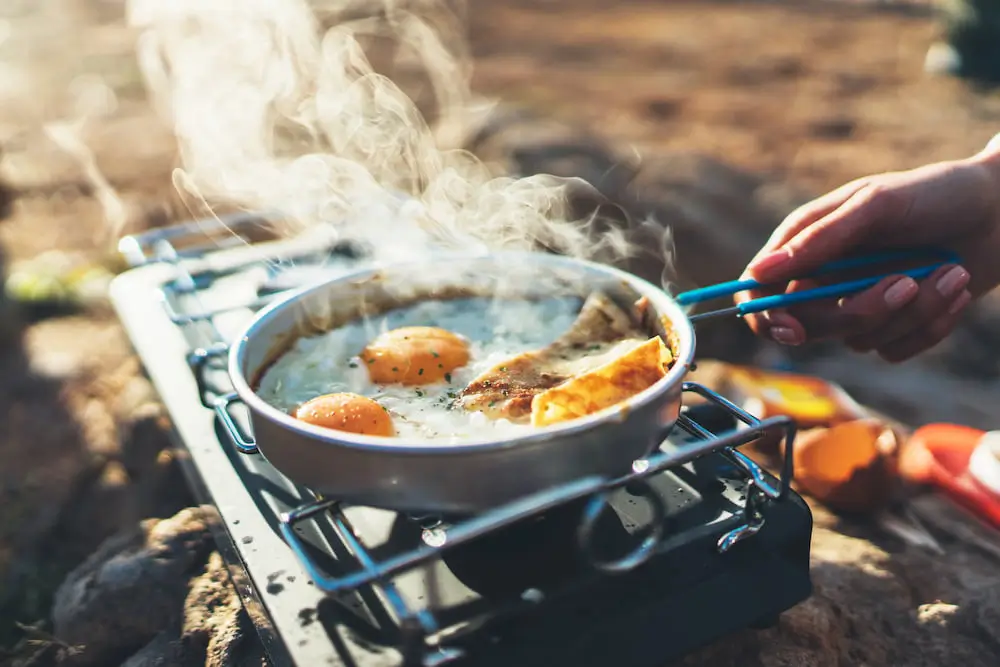
Cooking with your Camp Kitchen
The are a number of considerations when compiling your camp kitchen essentials. Cost, weight and functionality are all part of the balancing act.
While some campsites will have a built-in grill or firepit, don’t automatically count on using them. There may be open fire restrictions, or the grill top might be unusable. Plus, charcoal and wood fires take longer than a gas stove, so for these reasons, it’s always a good idea to have a camp stove to quickly prepare hot meals.
Stove – Weight, portability and useability are important factors in finding the right stove. As a rule of thumb, the more people you’re camping with, the more burners you want. If you’re camping with a group, multiple stoves are a good idea.
Cooking fuel – White gas is a popular camp fuel choice because it is easy to find and can be used for stoves and lantern lights. It only lasts a few months, so restock your white gas supply before each season.
Utensils and cutlery – Eschew plastics for biodegradable and reusable options. Make sure you have at least one kitchen knife, tongs, stirrers, serving implements and enough skewers for hot dogs and marshmallows. A cutting board and a whisk are also important to pack.
Pots and pans – At a minimum, you’ll want a skillet/frying pan and pot. Cast iron might be fashionable, but it’s heavy and problematic at clean-up time. Instead, consider pre-seasoned carbon steel or stainless steel with removable handles to make packing that much easier. If you have the space, you may also want a Dutch oven for advanced camp cooking.
Cooler – Unless you’re planning on granola bars and freeze-dried everything, you’re going to need a cooler to store perishables and keep beverages cold. While logically it might seem like the more expensive coolers will keep items colder for longer, that’s not always the case. Check out this Cooler Comparison Chart, with cost ranges, max ice life and more.
Ice and ice substitutes — The more perishables or cold beverages you want to bring, the more cooler space and ice you’ll need.
Food – It’s a good idea to have a couple of days’ worth of emergency food rations on hand, but think of some one-pot or easy skillet meals to make, like spaghetti, burgers, hot dogs, eggs, pancakes, bacon and so on. Don’t think it’s doable? Here are 52 camp food ideas that look fairly straightforward.
The size and efficiency of your cooler might limit your choices of perishables but dried and canned foods, plus bread and pasta don’t need to be chilled if your trip outlasts your ice. Fresh fruits might not last as long, but don’t usually need to be chilled and are great options to have on hand.
Nuts, dried fruit and protein bars are great, especially for hikes, and shelf-stable peanut butter is a must-have. Don’t forget the coffee (get instant if you must, but camp coffee brewed in a percolator is the best!) or tea.
Water – Plan on at least one gallon of water per person per day for hydration, but the amount can vary depending on the location, time of year, availability of fresh water, etc. Washing dishes, taking showers and general cleanup will increase water consumption quickly so plan ahead.
Bringing water from home is often the safest idea, as your body is already adjusted. It’s also cheaper and better for the environment than single-use bottles. If there is no potable water at or near your campsite, locally sourced water can be boiled or treated using water-purifying water pumps or tablets to make it drinkable.
Water bottles, mugs and cups – Fill water bottles before you leave home, then refill them before hikes and adventures. Mugs are must-haves for hot beverages (coffee, tea, cocoa) and also work for soup. Cups can be used for measuring, plus anything you’re drinking that’s not water.
Other – Salt, pepper and sweeteners don’t take up a lot of room, last a long time, and can save an otherwise boring meal. Cooking oil can also last a long time and will make cooking much easier.
Having a wash bin is important, as is biodegradable soap. Sponges, dish towels and pot scrubbers are good to have on hand. Multiple trash bags are a must-have since you should pack out everything you packed in.
Camp kitchen organization
Keep your camp kitchen organized in two bins, one for non-food items and a clear one just for non-perishable foodstuffs. Don’t keep any food in your bins between camping trips to avoid insect or rodent infestation.
Side note: Depending on where you camp, your cooler and food bins may have to be kept yards away from camp and sealed to prevent animals from dropping by unannounced. Never take food into your tent.
Clothing
Where you’re camping will influence your choice of clothing, but we’ve got the basics listed below. Keep in mind that even in the desert, nights can get very cold and uncomfortable, so it’s better to bring a heavy coat and not need it than need it and not have it.
- Hat — baseball or brimmed, plus knit cap
- Bandanna
- Sunglasses
- Belt
- Socks – 1 to 2 extra pairs more than you plan to wear
- Waterproof rain gear and/or rain jacket or poncho
- Clothes that allow for wicking, especially undergarments
- Light and heavy outerwear — fleece, vest, insulated jackets
- Sturdy long pants (ripstop material, heavy denim)
- Extra shoes or boots
- Optional – Shorts, swimwear
Keeping your clothing organized
Most of the clothes you bring should fit in your backpack and should go into your tent with you at night. If you’re car camping, the cold weather gear and extra boots/shoes can usually stay in the car, if it’s not too far away.
Tools and Equipment
It’s important to have some basics on hand for gathering wood, lighting fires and doing light chores around the campsite.
- Matches, lighters, firestarters
- Mallet – for hammering the stakes (an ax butt can be substituted)
- Ax – for firewood and hammering the stakes
- Saw – for firewood
- Rope/bungie cords
- Pocket knife and/or multi-tool
- Shovel or trowel
- Flashlights and batteries
- Walkie-Talkies
Keeping tools and equipment organized
Most all of these items can go directly into one of your storage bins. Shelter and warmth often take priority when setting up camp, so pack those items last so they stay toward the top.
Health and Safety
Pre-made first-aid kits are a must-have, even if it just stays in the trunk of your car the whole trip. But there are a few other considerations to add to your camp bins as well.
- First-aid kit
- Emergency blanket
- Insect repellent
- Lip balm
- Sunscreen
- Candles
- Toilet paper
- Packable towels
- Optional: Camp shower
Extras
Don’t forget to include small activities to do during downtime or if you’re weather-bound in the tent. Add a deck of cards, a camp game or two, or maybe even a book to your backpack or one of your bins. Telescopes and binoculars can be used to spy the stars or watch the wildlife. Bluetooth speakers can be taken, just be respectful of nearby campers.
Plastic bins are your friend
We’re not really sure how people car-camped before the invention of the plastic tote bin. These can be pre-packed for days or weeks before a camping trip, can be stacked in your storage unit, garage, closet or basement, and are easy to handle and load into the back of a car, truck or SUV. The plastic makes them virtually weatherproof. What’s more, if you re-pack them correctly after each trip, you can store them out of sight in a storage unit until your next adventure.
For a couples’ weekend campout, two 18-gallon (72-quart) totes are acceptable, but two (or three) 24- to 27-gallon bins would be ideal. In addition, each person should have one duffel or backpack for clothes. A cooler is also a must for perishables, and a (clean) water container is important. You’ll want a clear food bin, too, just wait to pack it right before your adventure.
For a more eco-friendly option, consider a pack-away bin made of recycled material or even a waxed canvas duffel.
Getting Packed
Put the most important items in your bins last so they are on top. Things like ground cover, tent stakes and your mallet or ax should be on top, followed by the tent, so you can get that set up right away. Sleeping bags and backpacks might be the first things packed in your vehicle, and then the last things taken out.
Same goes for packing food (don’t put breakfast on top, think about the meal you’re making after you get there), or your backpack (your emergency sweater can be at the bottom).
When packing up to come home, make sure you’re not putting anything dirty or wet into your plastic bins. If so, you’ll have to clean and dry them when you get home, as excess moisture will lead to mold or mildew, potentially ruining your camping equipment.
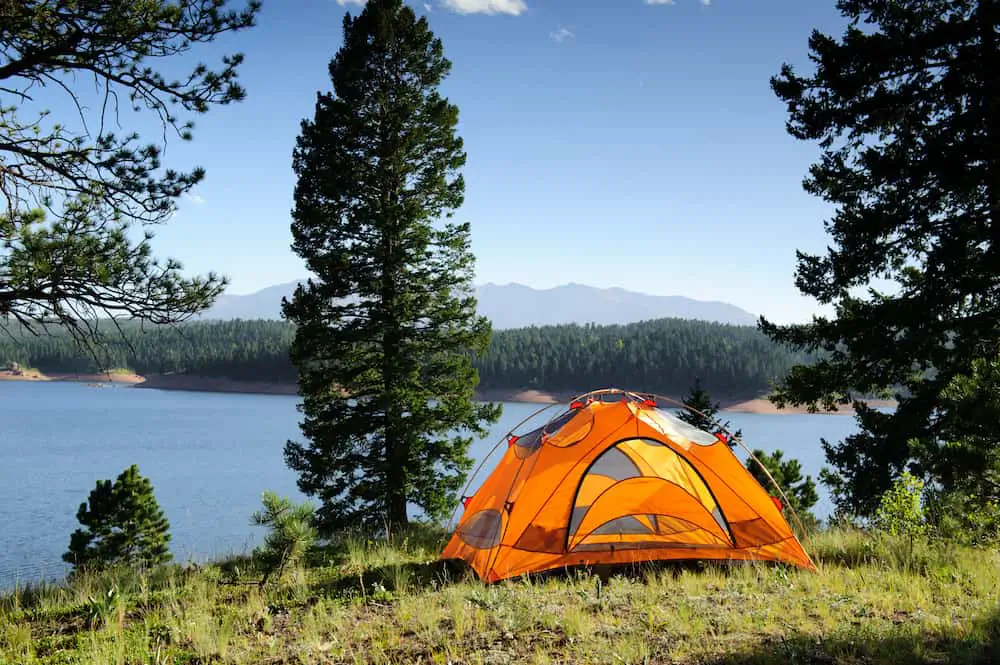
Final Note
We understand that not everyone has the room to store several bins’ worth of camping gear. That shouldn’t prevent you from enjoying the great outdoors, though.
Between adventures, you can store *most* of your camping gear by renting a self-storage unit. (No food or fuel, please.) With gates open from 6 a.m. until 10 p.m., 7 days a week at most Store Space locations, you can pick up your gear before heading out of town, then drop it off on your way home. What could be easier? Store Space offers affordable storage units for all your outdoor gear. You can find your nearest facility using our storage location finder.
